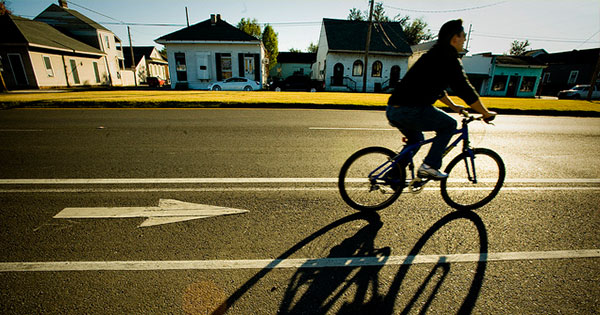
Among the more visible changes in New Orleans city life since Katrina has been an upsurge in bicycling. For a few years following Katrina, I felt alone on side streets when tooling around on my 1978 Raleigh, the first purchase I made after moving here.
Today, I more often find myself in bike scrums at the stoplight at Camp and Clio streets, where uptown bikers converge en route to downtown. It’s become more difficult to find bike-free signposts to lock up in the French Quarter. Sometimes, peddling along with a half-dozen strangers along skillet-flat streets, I feel as if I’m biking in Holland.
Except I know it’s not Holland, because a lot of drivers seem to regard on-street bike lanes as right-side passing lanes that happen to be strangely narrow. And many New Orleans bikers seem okay with biking the wrong way up one-way streets—and then yelling at other bikers when they get in their way. Also, I’d wager your bike has a higher chance of being stolen here than abroad. If you use a cable lock, my advice is to save the bother and just tie your bike to a lamppost with a piece of discarded gift ribbon. Bikewise, it’s still the Wild West here.
The rise in bike popularity appears to come from both an influx of newcomers accustomed to getting around on bikes, as well as city policy that encourages more biking. In the past decade the city has gone from zero bike lanes to dozens—as formerly flooded streets get repaved, bike lanes suddenly appear.
Although not without controversy. And that’s all coming to a head now on Napoleon Avenue. A grand uptown boulevard that is the route of many Mardi Gras parades, Napoleon Avenue is lined with majestic live oaks on either side of a wide and grassy neutral ground, or what everyone but New Orleanians call a median strip.
Much of the avenue has been ripped up for the past couple of years—it’s part of a massive, life-disrupting project called the Southeast Louisiana Urban Flood Damage Reduction Project, and it’s essentially the local version of Boston’s Big Dig. The city is installing subway tunnel–sized water-storage containment systems underground to take some of the pressure off the pumps during heavy downpours—the idea is to put storm runoff below ground, then pump it out gradually. It’s a 1990s-era project that broke ground just in time for environmental engineers to decide that stashing water underground is not the best idea; now the consensus seems to be to divert stormwater to natural bayous that run through linear neighborhood parks. No doubt children being born today will as adults have to deal with widespread traffic disruptions when contractors tear up the tunnels and replace them with a greenswards and canals fit for canoeing.
Anyway, the city recently announced that part of the plan for repaving Napoleon Ave. will be to reduce the neutral ground’s grassy width from about 46 feet to 37 feet in order to add bike lanes. This is in accord with the city’s Complete Streets plan, which passed in 2011 and calls for streets to be designed for bikers and walkers as well as for drivers.
This 20 percent reduction in this strip of green seemed pretty innocuous, but it’s set off a firestorm. My online neighborhood forum normally has a few posts a week about roofers and stray dogs. But lately it’s exploded over the proposed desecration of the neutral ground, what has become the Gaza Strip of the Big Easy.
Alternatives suggested by neighbors include leaving the neutral ground as is and reducing car travel from two lanes each direction to one to allow a bike lane; installing a bike lane within the neutral ground; or just leaving everything as is and shunting bikes off on side streets.
It’s a hot issue—and not just because it involves a beloved avenue. It’s a showdown between three factions with three visions of future urban life. One faction is fighting for every inch of green space, along with sacred Mardi Gras ground. Another wants to preserve the right to get around unhindered in air-conditioned boxes, and doesn’t much like sharing streets with bikers who often consider traffic laws optional. A third faction sees the rise of bikes as both morally right and inevitable, and believes the city should work to be more accommodating.
Such are the labor pains of a city giving birth to an alien bicycle culture.
One point of agreement: the city needs to work better with its neighborhoods in resolving these sorts of issues. A communications person from the Army Corps of Engineers sent a strikingly tone-deaf letter to one constituent that said, essentially, the narrowing of the neutral ground was a fait accompli, thank you for your interest, now go away.
Given all the clamor, the planning process for the new avenue may be reopened. (A deadline for feedback to the Army Corps of Engineers had been this week.) Which points up another citywide change since the storm: the rise of neighborhood and community activism may be an even more prominent emblem of post-Katrina New Orleans than the rise of biking. Fait accompli seems to have been washed away with much else.
Nothing like nearly losing your city to make residents understand that the future may be found in nine feet of grass.

